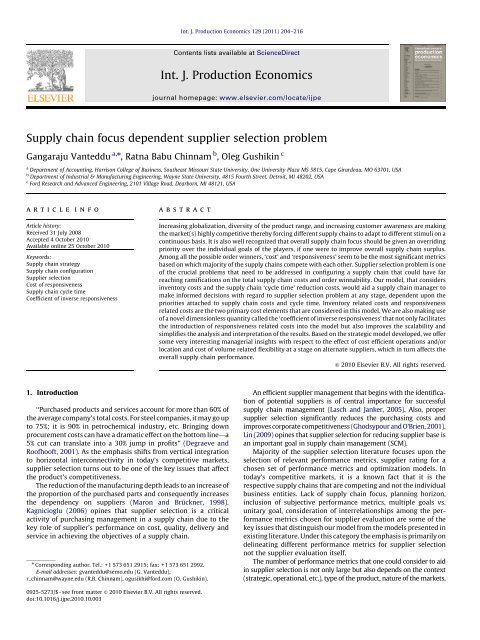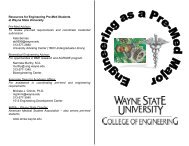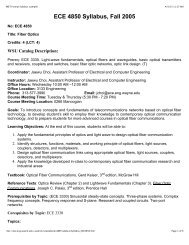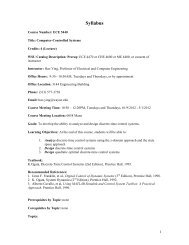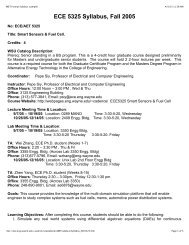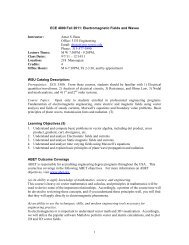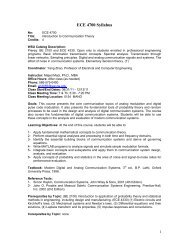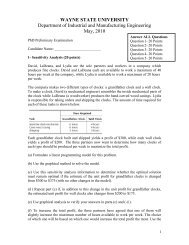Supply chain focus dependent supplier selection problem
Supply chain focus dependent supplier selection problem
Supply chain focus dependent supplier selection problem
Create successful ePaper yourself
Turn your PDF publications into a flip-book with our unique Google optimized e-Paper software.
Int. J. Production Economics 129 (2011) 204–216Contents lists available at ScienceDirectInt. J. Production Economicsjournal homepage: www.elsevier.com/locate/ijpe<strong>Supply</strong> <strong>chain</strong> <strong>focus</strong> <strong>dependent</strong> <strong>supplier</strong> <strong>selection</strong> <strong>problem</strong>Gangaraju Vanteddu a,n , Ratna Babu Chinnam b , Oleg Gushikin ca Department of Accounting, Harrison College of Business, Southeast Missouri State University, One University Plaza MS 5815, Cape Girardeau, MO 63701, USAb Department of Industrial & Manufacturing Engineering, Wayne State University, 4815 Fourth Street, Detroit, MI 48202, USAc Ford Research and Advanced Engineering, 2101 Village Road, Dearborn, MI 48121, USAarticle infoArticle history:Received 31 July 2008Accepted 4 October 2010Available online 25 October 2010Keywords:<strong>Supply</strong> <strong>chain</strong> strategy<strong>Supply</strong> <strong>chain</strong> configurationSupplier <strong>selection</strong>Cost of responsiveness<strong>Supply</strong> <strong>chain</strong> cycle timeCoefficient of inverse responsivenessabstractIncreasing globalization, diversity of the product range, and increasing customer awareness are makingthe market(s) highly competitive thereby forcing different supply <strong>chain</strong>s to adapt to different stimuli on acontinuous basis. It is also well recognized that overall supply <strong>chain</strong> <strong>focus</strong> should be given an overridingpriority over the individual goals of the players, if one were to improve overall supply <strong>chain</strong> surplus.Among all the possible order winners, ‘cost’ and ‘responsiveness’ seem to be the most significant metricsbased on which majority of the supply <strong>chain</strong>s compete with each other. Supplier <strong>selection</strong> <strong>problem</strong> is oneof the crucial <strong>problem</strong>s that need to be addressed in configuring a supply <strong>chain</strong> that could have farreaching ramifications on the total supply <strong>chain</strong> costs and order winnability. Our model, that considersinventory costs and the supply <strong>chain</strong> ‘cycle time’ reduction costs, would aid a supply <strong>chain</strong> manager tomake informed decisions with regard to <strong>supplier</strong> <strong>selection</strong> <strong>problem</strong> at any stage, <strong>dependent</strong> upon thepriorities attached to supply <strong>chain</strong> costs and cycle time. Inventory related costs and responsivenessrelated costs are the two primary cost elements that are considered in this model. We are also making useof a novel dimensionless quantity called the ‘coefficient of inverse responsiveness’ that not only facilitatesthe introduction of responsiveness related costs into the model but also improves the scalability andsimplifies the analysis and interpretation of the results. Based on the strategic model developed, we offersome very interesting managerial insights with respect to the effect of cost efficient operations and/orlocation and cost of volume related flexibility at a stage on alternate <strong>supplier</strong>s, which in turn affects theoverall supply <strong>chain</strong> performance.& 2010 Elsevier B.V. All rights reserved.1. Introduction‘‘Purchased products and services account for more than 60% ofthe average company’s total costs. For steel companies, it may go upto 75%; it is 90% in petrochemical industry, etc. Bringing downprocurement costs can have a dramatic effect on the bottom line—a5% cut can translate into a 30% jump in profits’’ (Degraeve andRoofhooft, 2001). As the emphasis shifts from vertical integrationto horizontal interconnectivity in today’s competitive markets,<strong>supplier</strong> <strong>selection</strong> turns out to be one of the key issues that affectthe product’s competitiveness.The reduction of the manufacturing depth leads to an increase ofthe proportion of the purchased parts and consequently increasesthe dependency on <strong>supplier</strong>s (Maron and Brückner, 1998).Kagnicioglu (2006) opines that <strong>supplier</strong> <strong>selection</strong> is a criticalactivity of purchasing management in a supply <strong>chain</strong> due to thekey role of <strong>supplier</strong>’s performance on cost, quality, delivery andservice in achieving the objectives of a supply <strong>chain</strong>.n Corresponding author. Tel.: +1 573 651 2915; fax: +1 573 651 2992.E-mail addresses: gvanteddu@semo.edu (G. Vanteddu),r_chinnam@wayne.edu (R.B. Chinnam), ogusikhi@ford.com (O. Gushikin).An efficient <strong>supplier</strong> management that begins with the identificationof potential <strong>supplier</strong>s is of central importance for successfulsupply <strong>chain</strong> management (Lasch and Janker, 2005). Also, proper<strong>supplier</strong> <strong>selection</strong> significantly reduces the purchasing costs andimproves corporate competitiveness (Ghodsypour and O’Brien, 2001).Lin (2009) opines that <strong>supplier</strong> <strong>selection</strong> for reducing <strong>supplier</strong> base isan important goal in supply <strong>chain</strong> management (SCM).Majority of the <strong>supplier</strong> <strong>selection</strong> literature <strong>focus</strong>es upon the<strong>selection</strong> of relevant performance metrics, <strong>supplier</strong> rating for achosen set of performance metrics and optimization models. Intoday’s competitive markets, it is a known fact that it is therespective supply <strong>chain</strong>s that are competing and not the individualbusiness entities. Lack of supply <strong>chain</strong> <strong>focus</strong>, planning horizon,inclusion of subjective performance metrics, multiple goals vs.unitary goal, consideration of interrelationships among the performancemetrics chosen for <strong>supplier</strong> evaluation are some of thekey issues that distinguish our model from the models presented inexisting literature. Under this category the emphasis is primarily ondelineating different performance metrics for <strong>supplier</strong> <strong>selection</strong>not the <strong>supplier</strong> evaluation itself.The number of performance metrics that one could consider to aidin <strong>supplier</strong> <strong>selection</strong> is not only large but also depends on the context(strategic, operational, etc.), type of the product, nature of the markets,0925-5273/$ - see front matter & 2010 Elsevier B.V. All rights reserved.doi:10.1016/j.ijpe.2010.10.003
G. Vanteddu et al. / Int. J. Production Economics 129 (2011) 204–216 205etc. Among the possible order winners cost and responsiveness turnout to be more crucial than others. In the context of our model,responsiveness is the ability of the supply <strong>chain</strong> to respond quickly tochanging customer needs, preferences, options, etc. in terms of supply<strong>chain</strong> cycle time, emphasis being on volume related flexibility. Majorityof the existing models are cost <strong>focus</strong>ed and do not address theresponsiveness aspect in an explicit fashion. Also interrelationshipsbetween cost and responsiveness are not sufficiently explored. Both ofthese issues are addressed in our model. Another major difference isthat the model works on the strategic perspective with the aim ofdeveloping managerial insights that would aid <strong>supplier</strong> <strong>selection</strong> at aparticular stage in a supply <strong>chain</strong>.We are modeling the <strong>supplier</strong> <strong>selection</strong> <strong>problem</strong> as a supply<strong>chain</strong> configuration <strong>problem</strong> in the sense that we are assuming thatproduct design and supply <strong>chain</strong> topology are already fixed andthere are competing <strong>supplier</strong>s at a stage who differ only in terms ofcost and responsiveness. A typical configuration for a supply <strong>chain</strong>consists of defining components of the system, assigning values tocharacteristic parameters of each component and setting operationpolicies for governing the interrelationships among these components(Truong and Azadivar, 2005).There are primarily four drivers of cost in a supply <strong>chain</strong>, namely,infrastructure, inventories, transportation and information (Chopraand Meindl, 2004). Since we are assuming that the necessary networktopology is already in place, it obviates the necessity to includeinfrastructure related cost elements and transportation relatedaspects explicitly into our model. However, these issues areaddressed in an indirect fashion in our model. For example, costadded at a stage can be considered to be a function of fixed costsassociated with infrastructure such as location, buildings, machinery,etc. Even though we are developing the model assuming that all thestages are involved in manufacturing, a stage purely dealing withtransportation could be easily accommodated. We are also assuminginformation symmetry at all the stages and leave informationasymmetry related issues for future research. That leaves us withinventory as our primary cost driver. We are considering both cyclestocks (in-process inventory) and safety stocks in our model.For a stochastic service model (Graves and Willems, 2003;Simchi-Levi and Zhao, 2005; Lee and Billington, 1993; Ettl et al.,2000), which we have adopted in our model, we assume that theincrease in cost at a stage depends on the opportunities that existfor resource flexibility. We model it as a continuous function of anovel dimensionless parameter called the ‘coefficient of inverseresponsiveness’ (CIR) that also enhances the scalability of the model,with the <strong>focus</strong> being to develop managerial insights with regard to<strong>supplier</strong> <strong>selection</strong> at a stage. With the introduction of CIR, research gapsin terms of addressing the interrelationship between the costs and theresponsiveness and the scalability limitation are addressed. Also, lack ofexplicit consideration of the processing time variability is one of the keyissues in the existing literature. We have included both the demandvariability and the processing time variability in our model therebymimicking the reality as closely as possible.The rest of this manuscript is organized as follows. In Section 2we present the relevant literature review. Section 3 deals with thedevelopment of the overall cost expression for the supply <strong>chain</strong>.Section 4 offers managerial insights in regards to the <strong>supplier</strong><strong>selection</strong> <strong>problem</strong> in a serial supply <strong>chain</strong>. Section 5 offers anillustrative example involving the <strong>selection</strong> of a wiring harness<strong>supplier</strong> for an OEM facility. Finally, conclusions and limitations areoffered in Section 6.2. Literature reviewPrimarily, the literature dealing with <strong>supplier</strong> <strong>selection</strong>/management can be broadly classified into three categories.First category deals with choosing the appropriate performancemetrics that aid in <strong>supplier</strong> <strong>selection</strong> and evaluation. The number of<strong>supplier</strong> performance metrics varies from 13 to 60 in differentpublications (Huang and Keskar, 2007). Huang and Keskar (2007)opine that cost and quality have been the most dominant factorsalong with on-time delivery and flexibility. Hsu et al. (2006)develop and validate a <strong>supplier</strong> <strong>selection</strong> construct anddemonstrate that underlying the documented <strong>supplier</strong> <strong>selection</strong>criteria there is need to assess a <strong>supplier</strong>’s quality and servicecapabilities as well as its strategic and managerial alignment withthe buyer. Quality, delivery, price of materials and services,responsiveness and service consistently emerge to be theimportant criteria for <strong>supplier</strong> <strong>selection</strong> (Kannan and Tan, 2002;Verma and Pullman, 1998). Huang and Keskar (2007) presentan integration mechanism in terms of a set of comprehensiveand configurable metrics arranged hierarchically that takes intoaccount product type, <strong>supplier</strong> type and OEM/<strong>supplier</strong> integrationlevel. The introduction of degree of alignment with the buyer is anovel feature in Hsu et al. (2006) and Huang and Keskar (2007).Under this category the emphasis is primarily on delineatingdifferent performance metrics for <strong>supplier</strong> <strong>selection</strong> not the<strong>supplier</strong> evaluation itself, which is the primary theme that weare trying to address in our research.Second category in <strong>supplier</strong> <strong>selection</strong>/management literaturedeals with <strong>supplier</strong> rating/evaluation methods for a given set ofperformance metrics (Lasch and Janker, 2005; Timmermann, 1986;Weber et al., 1991). Lasch and Janker (2005) designed a supplerrating system that uses principal component analysis to create aclassification and ranking of the potential <strong>supplier</strong>s by means ofellipsoid clusters. Huang and Keskar (2007) is a useful reference forliterature review for <strong>supplier</strong> <strong>selection</strong> using Analytical HierarchyProcess (AHP), Multi Attribute Utility Theory (MAUT) andoutranking methodologies. A thorough description of <strong>supplier</strong>rating methods with respect to their popularity and otherfeatures can be found in Lasch and Janker (2005). Reader canalso refer to AHP models (Barbarosoglu and Yazgac, 1997; Nydickand Hill, 1992) that deal with <strong>supplier</strong> <strong>selection</strong> <strong>problem</strong>s. In thiscategory the primary emphasis is on <strong>supplier</strong> rating for a given setof performance metrics using different quantitative approaches.Importance attached to the interrelationships between differenceperformance metrics and how those interrelationships affect thecompetitiveness of an organization is one of the key differencesbetween this line of research and the model presented in thisresearch paper.In the third category, suppler <strong>selection</strong> <strong>problem</strong> is treated as apart of an optimization <strong>problem</strong>. To account for many conflicting andvague objectives and constraints in making <strong>supplier</strong> <strong>selection</strong>decisions, Kagnicioglu (2006) proposes a fuzzy multi-objectivemodel, where both the objectives and some of the constraints arefuzzy. Morlacchi (1997) developed a model that combines the use offuzzy set theory with AHP and implements it to evaluate small<strong>supplier</strong>s in engineering and machine sectors. Kumar et al. (2004)used fuzzy goal programming to deal with the effect of informationuncertainty in <strong>supplier</strong> section <strong>problem</strong>s. Application of differentweights to the chosen set performance metrics to aid in <strong>supplier</strong><strong>selection</strong> is another established procedure. Reader can refer to linearweighting models (Cooper, 1977; Mazurak et al., 1985) for moreinformation. Use of fuzzy variables and linear weighting modelsbring an element of subjectivity into the model, which is always notdesirable. Also, emphasis on too many factors might sometimesdilute the significance of important performance metrics, whichcould be the order winners for the product in context.Ghodsypour and O’Brien (1997) used an integrated AHP modelwith mixed integer programming to reduce the number of <strong>supplier</strong>s.Integrating AHP model into the optimization architecture is thedistinguishing feature of this model. Ghodsypour and O’Brien (2001)
206G. Vanteddu et al. / Int. J. Production Economics 129 (2011) 204–216developed a mixed integer non-linear programming (NLP) approachfor <strong>supplier</strong> <strong>selection</strong> to minimize the total cost of logistics, includingnet price, storage, ordering costs and transportation. This approachfacilitates the inclusion of non-linear objective function and/orconstraints into the model, when compared to other optimizationmodels mentioned previously. Use of goal programming for <strong>supplier</strong><strong>selection</strong> is the distinguishing feature of Karpak et al. (1999). Tosystematically analyze the tradeoffs between conflicting factors in<strong>supplier</strong> <strong>selection</strong>, Weber and Current (1993) used multi-objectivelinear programming. For a detailed list of optimizationmethodologies used in <strong>supplier</strong> <strong>selection</strong> literature, one can referto Huang and Keskar (2007). Cebi and Bayraktar (2003) propose amodel, wherein <strong>supplier</strong> <strong>selection</strong> <strong>problem</strong> has been structured asan integrated lexicographic goal programming (LGP) and AHP thatincludes both quantitative and qualitative factors. The novelapplication of a genetic algorithm by Truong and Azadivar (2005)in combination with mixed integer programming to determinesimultaneously the values of quantitative as well as policy variablesthat aid in making strategic decisions regarding facility locations,stocking locations, <strong>supplier</strong> <strong>selection</strong>, production policies,production capacities and transportation modes is an interestingpaper distinguishing it from the other optimization models.Talluri and Baker (2002) propose a multi-phase mathematicalprogramming approach for supply <strong>chain</strong> design. Even though theelement of subjectivity is not a primary concern in these modelsdilution of the <strong>focus</strong> on key order winners could still be a <strong>problem</strong>.The following examples motivated us in choosing the responsivenessas one of the key performance metrics in addition to thetraditional cost component. A close examination of the followingreal-world supply <strong>chain</strong>s and their objectives reveals that theresponsiveness is one of the key performance metrics that not onlyserves as an important order winner but also has a significant effecton overall costs. Nazzal et al. (2006) present a case study for AgereSystems’ wafer fabrication facility, wherein, they use simulation,design of experiments, and statistical analysis to constructoperating characteristic (OC) curves to relate cycle time toproduction volume capabilities for the subsequent economicanalysis. Agere Systems, one of the leading companies in themicroelectronics, is trying to increase its market share andprofits with the primary goal being able to quantify theeconomic impact of reducing lead times. This case study bringsout the importance of cost and responsiveness as the primary orderwinners in today’s highly competitive markets. Another interestingmotivating example is the Revlon’s supply <strong>chain</strong> addressed inDavis et al. (2005). Revlon’s supply <strong>chain</strong> includes more than5000 active finished good Stock Keeping Units (SKUs) withlife-cycles that last less than three years, sales in more than100 countries, seven manufacturing facilities and approximately450 <strong>supplier</strong>s located around the world. To meet its aggressiveinventory reduction targets and achieving high customer servicelevels, Revlon realized that it would be possible only by reducingthe manufacturing and <strong>supplier</strong> lead times and the associatedvariability. This example also emphasizes cost and responsivenessas the primary levers that help in achieving the supply <strong>chain</strong> goals.There are similar examples from other industries. For example,automobile industry is no longer <strong>focus</strong>ing upon manufacturingmass volumes, instead <strong>focus</strong>ing more upon flexibility to respond tochange because of the shrinking model life-cycles with the goal oflowering the capital investment required for changeover orintroduction of a new product (Pelagagge, 1997).Vickery et al. (1999) emphasize the importance of <strong>supplier</strong>responsiveness to changing buying needs particularly in anenvironment characterized by short product life-cycles anddownward pressure on product lead times. Yang and Geunes(2007) emphasize that longer lead times in addition to reducingthe customer responsiveness, increase demand forecast error, sinceforecast error generally increases as the forecast horizon increases.Also, longer lead times expose the supply <strong>chain</strong> to more in-processinventories, design changes, degradation, accidents, changes indemand patterns, etc. (Felgate et al., 2007), which in turn increasethe supply <strong>chain</strong> costs.The above-mentioned examples served as a motivation tochoose cost and responsiveness as the key order winners eventhough <strong>supplier</strong> <strong>selection</strong> <strong>problem</strong> was not their primary <strong>focus</strong>.Since we are addressing the issue of <strong>supplier</strong> <strong>selection</strong> as asupply <strong>chain</strong> configuration <strong>problem</strong> in our model a brief literaturereview of supply <strong>chain</strong> configuration models will be in order.Huang et al. (2007) dealt with optimizing the configuration of aset of platform products and the associated supply <strong>chain</strong> consistingof one manufacturer and multiple <strong>supplier</strong>s using a three movedynamic game theoretic approach. They describe the integratedconfiguration of platform products and supply <strong>chain</strong> (ICPPSC) gameas a dynamic multi-stage non-cooperative configuration game.In this game, the manufacturer is treated as the leader and <strong>supplier</strong>sas followers. The decision variables to be optimized are mainlyconcerned with product and supply <strong>chain</strong> configuration, including<strong>supplier</strong> <strong>selection</strong> and <strong>selection</strong> of module options. As with Hsuet al. (2006), our research is more suitable for selecting strategicallyimportant <strong>supplier</strong>s that aid in realizing the supply <strong>chain</strong> strategyrelated goals than <strong>supplier</strong>s of commodities, wherein <strong>supplier</strong><strong>selection</strong> is likely to <strong>focus</strong> on short-term price/cost tradeoffs.Graves and Willems (2003) address the <strong>problem</strong> of how toconfigure the supply <strong>chain</strong> for a new product for which theproduct’s design has already been decided and the topology forthe supply <strong>chain</strong> network has been set to determine <strong>supplier</strong>s,parts, processes and transportation modes at each stage.Cakravastia et al. (2002) present a mathematical approach fordesign of the supply <strong>chain</strong> configuration at two stages, operationaland supply <strong>chain</strong> levels.Now, let us examine the relevant literature specifically inrelation to the strategic mathematical model we adopted. Therelevant literature review is largely adapted from Vanteddu et al.(2007). Gallego and Zipkin (1999) develop and analyze severalheuristic methods to study the <strong>problem</strong> of stock positioning inserial production-transportation systems and offer a number ofinteresting insights into the nature of the optimal solution.Stochastic service model as advocated by Graves and Willems(2003) addresses the issue of strategic placement of safety stocksacross a multi-echelon supply <strong>chain</strong> in the presence of demanduncertainty. The primary purpose of their model is to develop amulti-echelon model and the relevant optimization algorithm thatis specifically designed for optimizing the placement of safetystocks in real-world supply <strong>chain</strong>s. Unlike Graves and Willems(2003), where inventory is the only lever to counter demandvariability, our model has two levers, namely, inventory andresponsiveness (cycle time) at each stage.Following are some of the prominent inventory models thatmake use of the concepts of stochastic service model and/orinstallation policy, which we used in our model. By assuming aninstallation, continuous-time base stock policy for supply <strong>chain</strong>swith tree network structures, another interesting paper that isbased on the stochastic service model concept is Simchi-Levi andZhao (2005), wherein, they derive recursive equations for the backorder delay (because of stock out) at all stages in the supply <strong>chain</strong>and based on those recursive equations, dependencies of theback order delays across different stages of the network arecharacterized and useful insights with respect to the safety stockpositioning are developed in various supply <strong>chain</strong> topologies. Inaddition, Simchi-Levi and Zhao (2005) present a good summary ofthe literature for installation policies that are used in variousnetwork topologies: multi-stage serial systems (Simpson, 1958;Hanssmann, 1959; Lee and Zipkin, 1992) and distribution systems
G. Vanteddu et al. / Int. J. Production Economics 129 (2011) 204–216 207(Axsäter, 1993; Graves, 1985; Lee and Moinzadeh, 1987a, b). Forcapacitated models using a modified base stock policy, the readercan refer to Glasserman and Tayur (1995, 1996) and Kapuscinskiand Tayur (1999). For a thorough comparison of installation andechelon stock policies for multi-level inventory control, the readeris referred to Axsäter and Rosling (1993). They primarily considerserial and assembly systems and prove that for (Q, r) rules echelonstock policies are, in general, superior to installation stock policies.Advocating the necessity of models that include both costand responsiveness, which are the primary order winners in ourstrategic model, Moon and Choi (1998) suggest extending the leadtime reduction concept to other inventory models to justify theinvestment to reduce the lead times. Choi (1994) used an expeditingcost function to reduce the variance of <strong>supplier</strong>’s lead times. Asopposed to network design models that <strong>focus</strong> on the tradeoffbetween the fixed costs of locating facilities and variabletransportation costs between facilities and customers, Sourirajanet al. (2007) present a model for single product distribution networkdesign <strong>problem</strong> with lead times and service level requirements,which enables them to capture the tradeoff between lead times andinventory risk pooling benefits. The objective is to locate distributioncenters (DCs) in the network such that the sum of the location andinventory (pipeline and safety stocks) costs is minimized.One very interesting (Q, r) model with stochastic lead times thatcould serve as a building block in supply <strong>chain</strong> management isproposed by Bookbinder and Cakanyildirim (1999) as opposed toconstant lead time assumption in many other studies. Thedimensionless quantity CIR proposed in our model is similar in spiritto the ‘‘expediting factor’’ for the lead time proposed by them. Ryu andLee (2003) consider dual sourcing models with stochastic lead times inwhich lead times are reduced at a cost that can be viewed as aninvestment. They make use of the concept of ‘‘expediting factors’’proposed by Bookbinder and Cakanyildirim (1999) in their model. Theyanalyze (Q, r) models with and without lead time reduction andcompare the expected total cost per unit time for the two models.Even though, we did not consider the product mix flexibilityrelated issues in our model, the reader can refer to Upton (1997) forexploring the relationship between process range flexibility andstructure, infrastructure and managerial policy at the plant level.We assume information symmetry at all the stages in our model.The effect of information sharing for time series structure of thedemand on safety stocks is addressed in Gaur et al. (2005). Eventhough we did not address environmental issues, reader can referto Wolf and Seuring (2010) who analyze whether environmentalissues form a <strong>supplier</strong> <strong>selection</strong> criteria of companies when sourcingthird party logistics (3PL) services.3. Model developmentAt any stage in supply <strong>chain</strong> primarily there are two types ofinventory elements namely cycle inventory (in-process inventory)and safety inventory. The quantity of cycle inventory depends onthe average demand per period and the average cycle (processing)time and is given by the multiplied product of those two quantities.Among inventory cost elements, safety stock, which is maintainedto account for the internal and external variability in a supply <strong>chain</strong>,is vital in the sense that it directly affects customer satisfaction andsafety stock costs also constitute a significant portion of the cost ofgoods at a stage. We are considering both cycle stocks (in-processinventory) and safety stocks in our model. Responsiveness relatedcosts are the costs incurred on account of the volume relatedflexibility at any stage in a supply <strong>chain</strong>, the inclusion which intothe model is made possible by the inclusion of a new parametercalled coefficient of inverse responsiveness (CIR). The inclusion ofCIR also facilitates the explanation of the interrelationship betweeninventory costs and the responsiveness related costs.At any stage in a supply <strong>chain</strong>,Total cost¼Safety stock costs+Cycle stock costs+Responsivenessrelated costsThis section is devoted to developing total cost expression,made up of safety stock costs, cycle stock costs and responsivenessrelated costs, for a serial supply <strong>chain</strong>.3.1. Expression for safety stock costsThe content in Sections 3.1 and 3.2 is largely adopted fromVanteddu et al. (2007).We follow the building block model (Gravesand Willems, 2003) with installation base stock policies and acommon underlying review period for all stages. A typical basestock policy works as follows.When the inventory position (i.e., onhand plus on order minus back orders) at stage i falls below somespecified base stock level B i , the stage places a replenishment orderthereby keeping the inventory position constant. Simchi-Levi andZhao (2005) attribute the popularity of base stock policy to the factthat it is simple, easily implementable, and because this policy hasbeen proven to be optimal or close to optimal in many cases. Forexample, in serial supply <strong>chain</strong>s with zero setup costs and withoutcapacity constraints, because the installation base stock policy isequivalent to an echelon base stock policy under certain initialconditions (Axsäter and Rosling, 1993), it is indeed optimal in thesecases (Clark and Scarf, 1960).In serial systems, even modified basestock policy with capacity constraints is still close to optimal (Speckand vander Wal, 1991; Van Houtum et al., 1996)In an installation policy, each facility only needs the inputs fromthe immediate upstream (U/S) and downstream (D/S) facilities andmakes ordering decisions based on its local order and inventorystatus (Simchi-Levi and Zhao, 2005) as opposed to an echelon basestockpolicy, which is a centralized control scheme that allows for acentral decision maker to coordinate and control the actions at allstages in the SC (Graves and Willems, 2003).Even though our model assumes all the stages to be manufacturingstages, without loss of generality, a stage could be modeledas a distribution center (DC) as well. A pure transportation functioncan also be modeled with the building block concept, wherein thetransport time is the lead time with pipeline inventories.Orders are placed at discrete time intervals and each stage isconsidered as a building block (Graves, 1988) that generates astochastic lead time. A building block is typically a processor plus astock keeping facility (Simchi-Levi and Zhao, 2005). Depending onthe scope and granularity of the analysis being performed, the stagecould represent anything from a single step in manufacturing ordistribution process to a collection of such steps to an entireassembly and test operation (Graves and Willems, 2003). Demandis assumed to be stationary and uncorrelated across different timeperiods with no capacity constraints.Our model is designed as a decentralized supply <strong>chain</strong> (Gravesand Willems, 2003; Lee and Billington, 1993) to mimic the realitymore closely with each stage following a local base-stock policy.Buttressing the same view, Lee and Billington (1993) state thatorganizational barriers and restricted information flows betweenstages may result in complete centralized control of material flowin a supply <strong>chain</strong> to be not feasible or desirable.The primary distinction between centralized and decentralizedsupply <strong>chain</strong> is put in the following succinct form by Lee andBillington (1993) ‘‘Centralized control means that decisions on howmuch and when to produce are made centrally, based on materialand demand status of the entire system. Decentralized control, onthe other hand, refers to cases where each individual unit in thesupply <strong>chain</strong> makes decisions based on local information’’.
208G. Vanteddu et al. / Int. J. Production Economics 129 (2011) 204–216Assuming each building block operates in<strong>dependent</strong>ly using asimple installation policy, one can first characterize various buildingblocks such as serial, assembly, distribution, etc. and thenidentify the links among these building blocks (Simchi-Levi andZhao, 2005).We have chosen series system for the simplicity ofanalysis and primarily to develop certain insights that areinsensitive to the specific supply <strong>chain</strong> topology. Also, othernetworks such as assembly system can be reduced to anequivalent series system (Rosling, 1989). Most of the featuresare similar to the features of a serial system presented in Gallegoand Zipkin (1999) with some modifications.There are several stages or stocking points arranged in series.Thefirst stage receives supplies from an external source.Demand occurs only at the last stage. Demands that cannot befilled are immediately backlogged. There is one product, or moreprecisely, one per stage. To move units to a stage from itspredecessor, the goods must pass through a supply systemrepresenting production or warehousing activities. There is aninventory holding cost at each stage and our model does notconsider back order penalty cost, which could be easily included.The horizon is finite, all data are stationary, information iscentralized but control is decentralized.As in Gallego and Zipkin (1999), the numbering of the stagesfollows the flow of goods; stage one is the first and at the last stagedemand occurs. The external source, which supplies stage one hasample stock and it responds immediately to orders.We have assumed that the service level targets required at eachof the players are exogenous, i.e. dictated by the immediate D/Splayer or the final customer. Following Graves and Willems (2003)treatment of stochastic service model in supply <strong>chain</strong>s, LetFðk 1 Þ,...,Fðk n Þ be the service levels for corresponding safetyfactors k 1 ,...,k n where F(k i ) represents the cumulativedistribution function for a standard normal variable. k j is themultiplying factor for the variability term for stage j, whichalong with the average in-process inventory would give theexpected base stock to achieve a given service level. Let theprocessing time at stage j be a random variable t j (measured intime periods) with mean L j and variance s j 2 .The stochastic service model (Graves and Willems, 2003;Simchi-Levi and Zhao, 2005; Lee and Billington, 1993; Ettl et al.,2000) assumes delivery or service time between stages to varybased on the material availability at that stage and each stage in thesupply <strong>chain</strong> maintains a base stock sufficient to meet its servicelevel target (Graves and Willems, 2003). If D i is the random delayat the preceding stage i, then the replenishment cycle time atstage j equalsg j ¼ t j þD iWe have adopted the procedure for calculating this delay due tothe stock out at the preceding stage as presented in Graves andWillems (2003) and Ettl et al.(2000) with a modification that takesinto account the fact that there is only one player at the precedingstage. We are assuming that the expected value of this delay issimply equivalent to the probability of stock out at the precedingstage p i times its average processing time.Therefore, expected replenishment cycle time at stage j is given byE½g j Š¼L j þp i L ið2Þwherep i ¼ 1 Fðk i Þ ð3ÞAssuming that the demand is Nðm,s 2 Þ, where m is the meandemand during one time period and s 2 is the demand varianceduring one time period, to satisfy average demand m, given theð1Þaverage replenishment cycle time from (2), ‘average cycle stock’ isgiven bymðL j þð1 Fðk i ÞÞL i Þ ð4ÞAssuming the independence of processing times at a stage andbetween the stages we realize thats 2 D i¼ s 2 i ð1 Fðk iÞÞ ð5Þs 2 g j¼ s 2 j þs2 i ð1 Fðk iÞÞ ð6ÞWhen the demands are uncorrelated between time periods,then the mean and variance of the demand during replenishmentperiod for stage j denoted by the continuous random variable W J areobtained as follows by slightly modifying the equations to accountfor the portion of the lead time variability transferred from thepreceding stage (see for example, Eppen and Martin, 1988; Feller,1960).m Wj¼ mE½g j Šs 2 W j¼ s 2 E½g j Šþs 2 g jm 2Now, we introduce another parameter ‘c j ’ termed as the‘coefficient of inverse responsiveness (CIR)’ defined as the ratioof the average demand to the rate of production (throughput) p j .c j ¼ m=p jð8ÞAssuming that there is enough capacity at all the stages tosatisfy a given demand, c j r1 at all the times. When c j ¼1, expectedreplenishment cycle time is given by (2). We also assume that thereis some upper bound above which rate of production cannot beincreased further. CIR at a stage is similar to the ‘‘expediting factor’’proposed by Bookbinder and Cakanyildirim (1999). They define the‘‘expediting factor’’ t as the constant of proportionality betweenrandom variables T ~ (the expedited lead time) and T (ordinary leadtime). For expedited orders (to1) shorter than average lead timecan be obtained at a cost. Similarly, longer mean lead time results ina rebate for the customer when (t41). By considering a model withthree decision variables (Q, r, t), they show that the expected costper unit time is jointly convex in the decision variables and obtainthe global best solution.Keeping the average cycle stock constant (given in (4)), fromLittle’s law, at expedited rates of production (c j o1), replenishmentcycle time mean and variability for player j, when operating at a CIRlevel c j will be equivalent toE½g j Š¼ðL j þð1 Fðk i ÞÞL i Þc j ð9Þs 2 g j¼ðs 2 j þs2 i ð1 Fðk iÞÞÞc j ð10ÞAs c j decreases, average replenishment cycle time for player jdecreases, which means player j is becoming more responsive.Because of this inverse relationship between c j and responsiveness atstage j, c j is termed as ‘coefficient of inverse responsiveness’ at stage j.In light of Eqs. (9) and (10), we assume that demand duringreplenishment period W j for stage j, is normally distributed as follows:m Wj¼ mE½g j Šqffiffiffiffiffiffiffiffiffiffiffiffiffiffiffiffiffiffiffiffiffiffiffiffiffiffiffiffiffiffiffiffiffiffis Wj ¼ s 2 E½g j Šþðs 2 g jÞm 2ð7Þð11ÞThe above equation considers both the demand variability andthe replenishment cycle time variability. Replenishment cycle time
G. Vanteddu et al. / Int. J. Production Economics 129 (2011) 204–216 209variability is made up of two components1. Processing time variability at stage j.2. Portion of processing time variability at stage i that is transferredto stage j.We assume that base stock at stage j is given byB j ¼ mE½g j Šþk j s Wj , where k j is the safety factor to achieve theservice level target F(k j ) for that stage.After accounting for the average demand over the replenishmentperiod, expected on hand inventory is given byE½I j Š¼k j s Wjð12ÞBy augmenting the above expression with the following term,which is the expected number of Back orders (Graves and Willems,2003; Ettl et al., 2000)Z 1E½BOŠ¼s Wj ðzz ¼ k jk j ÞfðzÞdz ð13Þwe realize the following expression for the expected safety stock atstage j.E½SS j Š¼s Wj k j þZ 1ðzz ¼ k j!k j ÞfðzÞdzð14ÞAt stage j, let C j be the nominal cumulative cost of the productrealized when c j ¼1, and let h j be the holding cost rate per period.Per unit holding cost of safety stock at stage j per period equals C j h j .Total safety stock holding cost at stage j per period is given byCj SSC ¼ C j h j E½SS j Š ð15ÞTotal safety stock holding cost for the supply <strong>chain</strong> per period isgiven byC SSC ¼ Xnj ¼ 1C SSCj3.2. Responsiveness related costs at stage j:ð16ÞWhen players (1,y,n) operate with their respective CIRs being(c 1 ,y,c n ), stage j incurs two types of responsiveness related costs.3.2.1. Direct responsiveness related costsThe difference in nominal cumulative costs of the product atstages j and i (i.e., C j C i ) will increase by a value, which is assumedto be a function of (1 c j ). This is the cost that the stage j will pay foroperating at a higher processing speed that lowers the averagereplenishment cycle time at stage j.The increase in cost is typically due to increase in investment inthe so-called 5M resources (i.e., manpower, machine, methods,material and measurement). We are addressing the issue of cycletime reduction due to the opportunities for flexibility available at astage which can be harnessed at a cost. This should not be confusedwith cycle time reductions due to better operational efficienciessuch as efficient removal of wastes from the processes such as downtime, setup time, etc. Flexibility related costs will increase/decreasedepending on how flexible these 5M resources are at a stage.Direct response related costs at stage j per period are given byDRC j ¼½f ð1 c j ÞŠðC j C i Þm ð17ÞEven though we do not advocate any specific function type formodeling f(1 c j ), cost of volume flexibility function (COF), westrongly recommend that it be derived from the historical data.For example, for a specific average demand, from the past data onecould fit a regression model between (1 c j ) and the incrementalcost at a stage. Moon and Choi (1998) advocate the use of apiecewise linear crashing cost function that is widely used inproject management in which the duration of some activities canbe reduced by assigning more resources to the activities. They haveused a piecewise linear crashing cost function in their model. Ben-Daya and Raouf (1994) could be a useful reference to consider usingother types of crashing cost functions.Bookbinder and Cakanyildirim (1999) assume the expediting costper unit (because of technological investments or hiring extra workers)time c(t) to be a decreasing convex function of the expediting factorwith c(1)¼0 (additional cost when CIR¼1iszeroinourmodelaswell).As opposed to our model, they allow c(t) to take negative values fort41, meaning that for longer lead times they assume that themanufacturer gives the buyer some rebate per unit time.Proceeding from the research of Bookbinder and Cakanyildirim(1999), Ryu and Lee (2003) choose their expediting cost functionsc 1 (t 1 ) and c 2 (t 2 ) to be decreasing convex functions of theexpediting factors t 1 and t 2 .They considered c 1 ðt 1 Þ¼c 1 ð 1þ1=t 1 Þ and c 2 ðt 2 Þ¼c 2 ð 1þ1=t 2 Þ, where c 1 and c 2 arepositive coefficients. Our cost function, for example Eq. (17)looks similar in spirit to the above cost functions.Yang and Geunes (2007) expect the cost of reducing procurementtime, because of <strong>supplier</strong>’s investment in production processes ortechnologies, to increase at a non-decreasing rate in the amount oflead time reduction and therefore employ a convex function for leadtime reduction. They consider a piecewise linear, convex anddecreasing form (as the production lead time increases) for theunit procurement cost function but note that their analysis of thisfunction applies to general piecewise linear functions and convexityis therefore not required although they expect this function to beconvex in practical context. We, for our numerical analysis considera simple increasing convex function although the results would notbe different for any non-decreasing function.3.2.2. Indirect responsiveness related costsIn addition to the above mentioned ‘Direct responsiveness relatedcosts’, the stage will experience an increase in safety stock costs, whenit operates at c j for the reasons mentioned in Section 3.2.1. As a result,the difference in nominal cumulative costs of the product at stages jand i will increase by a value, which is a function of (1 c j ). Therefore,indirect responsiveness related cost at stage j is given byIRC j ¼½f ð1 c j ÞŠðC j C i Þh j E½SS j Š ð18ÞTherefore, total responsiveness related cost at stage j is given byTRC j ¼ DRC j þIRC jð19ÞHence, total safety stock costs in the presence of increase incosts at stage j that account for increase in the responsiveness perperiod is given byCjTSC ¼ Cj SSC þTRC j ð20ÞHence, total safety stock related cost for the whole supply <strong>chain</strong>per period is given byC TSC ¼ Xnj ¼ 1C TSCj3.3. Cycle inventory related costsð21Þ3.3.1. Cycle inventory at stage jAverage cycle stock cost at stage j per period is given byWIP j ¼½ðC j þC i Þ=2Šh j mðL j þð1 Fðk i ÞÞL i Þ ð22Þ
210G. Vanteddu et al. / Int. J. Production Economics 129 (2011) 204–2163.3.2. Responsiveness related cycle inventory costs at stage j:When players (1,y,n) operate with their respective CIRs being(c 1 ,y,c n ), stage j incurs response related cycle stock costs.Response related cycle stock cost at stage j is assumed toincrease the difference of average cycle stock value per unit atstages j and i, that is ððC i þC j Þ=2Þ ððC h þC i Þ=2Þ¼ððC j C h Þ=2Þ, byavalue, which is a function of ð1 c j Þ and ð1 c i Þ.RWIP j ¼½f ðð1 c j Þ,ð1 c i ÞÞŠ½ðC j C h Þ=2Šh j mðL j þð1 Fðk i ÞÞL i Þ ð23ÞTherefore total inventory and responsiveness related cost atstage j per period is given byTC j ¼ Cj SSC þTRC j þWIP j þRWIP j ð24ÞTotal inventory and responsiveness related cost for the wholesupply <strong>chain</strong> per period is given byTC SC ¼ XnTC jð25Þj ¼ 14. Model related resultsIn this section based on the supply <strong>chain</strong> total cost expression(25) developed in Section 3, we compare three hypothetical<strong>supplier</strong>s at stage 3 in a serial supply <strong>chain</strong> containing fivestages, stage 1 being the most upstream (closest to the rawmaterial <strong>supplier</strong>) and stage 5 being the most downstream(closest to the raw material <strong>supplier</strong>). Supplier <strong>selection</strong> will bemade based on the criterion of the least total supply <strong>chain</strong> cost.Particularly we explore the effect of increasing responsiveness onthe total supply <strong>chain</strong> costs under different scenarios for <strong>supplier</strong>swith different parameter values. We specifically <strong>focus</strong> on the effectof cost efficient operations or location, which is particularlyrelevant in the context of making outsourcing decisions and thecost of flexibility, which is a crucial determinant for success intoday’s highly competitive markets on the suitability of a specific<strong>supplier</strong> based on the total supply <strong>chain</strong> cost criterion and presentsome interesting counter intuitive managerial insights.4.1. <strong>Supply</strong> <strong>chain</strong> <strong>focus</strong> <strong>dependent</strong> <strong>supplier</strong> <strong>selection</strong> <strong>problem</strong>The total cost expression developed for a stage could be used asa building block for any network and by the use of mixed integernon-linear programming one could address the issue of <strong>supplier</strong><strong>selection</strong> at a stage.However, our <strong>focus</strong> is primarily to offer certain managerialinsights with respect to the <strong>supplier</strong> <strong>selection</strong> <strong>problem</strong> at a stage bybalancing the inventory costs with responsiveness related costs.The relevant insights can be used as an aid in <strong>supplier</strong> <strong>selection</strong>either for purchasing parts or to make outsourcing decisions(make/buy decisions) at a stage. As mentioned previously, weassume that the structural decisions are already made with respectto the supply <strong>chain</strong> topology and we know the values of theparameters such as lead times, inventory carrying costs, cost addedat a stage, nature of the cost of flexibility function, etc. We are alsoassuming that the competing <strong>supplier</strong>s are equivalent on otherattributes say quality, etc. that are not considered in the model.Our model deals with single sourcing not multiple sourcing, thatis, the whole order at a stage is serviced by just one <strong>supplier</strong>. Ordersplitting among <strong>supplier</strong>s is not permitted. Reader can refer toBurke (2005) for single versus multiple sourcing strategies underdifferent scenarios.And also we are assuming one buyer per stage, that is,collaborative procurement is not allowed. Reader can refer toSavasaneril (2004) to study the effects of demand aggregation andcollaborative procurement on buyer’s profitability.In this section, we attempt to study the <strong>supplier</strong> <strong>selection</strong><strong>problem</strong> by considering alternate <strong>supplier</strong>s with different valuesof key parameters such as replenishment cycle times, replenishmentcycle time variability, cost of holding inventory, cost of responsiveness,etc. Typical values of the parameters adopted for stages1 through 5 are presented in Table 1. Our purpose is to developinsights with respect to determining the <strong>supplier</strong> at stage 3(choosing one among 31, 32 and 33) who would be the best fit asthe supply <strong>chain</strong> <strong>focus</strong> moves on the cost–responsiveness spectrum.For the sake of simplicity <strong>supplier</strong>s 31, 32 and 33 are referred toas <strong>supplier</strong>s 1, 2 and 3, respectively.Based on the values of the parameters as shown in Table 2, all theother things being equal, the total supply <strong>chain</strong> cost increasesprogressively as we move from <strong>supplier</strong> 1 to <strong>supplier</strong> 3. The CIR ischanged from 1 to 0.3 in a discrete manner for all the five players atthe same time and total supply <strong>chain</strong> cost is calculated using Eq. (25).As CIR decreases, difference among the safety stock costs for<strong>supplier</strong> 1 vs. <strong>supplier</strong>s 2 and 3 diminishes due to the reduction inaverage processing time and the associated variability. Withdecrease in CIR, differences among indirect safety stock costsTable 2Key values of the parameters for the three potential <strong>supplier</strong>s.Supplier 1 2 3Mean processing time (periods) L j 1 1.5 2Processing time variability (m 2 s 2 j ) 100 300 600Inventory holding cost h j 0.017 0.025 0.034Table 1Typical values of the parameters adopted for this study.Stage/player1 2 3 4 5Nominal cumulative cost C j 106 150 240 472 1362Mean processing time (periods) L j 1.00 1.00 1.00 1.00 1.00Demand variability s 2 400 400 400 400 400Processing time variability (m 2 s 2 j )(in terms of number of units 2 of product)100 100 100 100 100Safety coefficient k j 1.28 1.28 1.28 1.28 1.28Average back order coefficient 0.1 0.1 0.1 0.1 0.1p j 0.1 0.1 0.1 0.1 0.1Average demand m 100 100 100 100 100Inventory holding cost h j 0.017 0.017 0.017 0.017 0.017Service level F(k j ) 0.9 0.9 0.9 0.9 0.9
G. Vanteddu et al. / Int. J. Production Economics 129 (2011) 204–216 211may increase or decrease depending on how steep or flat the cost offlexibility function is and the values of other parameters. Directresponse cost contribution, even though changes with CIR will bethe same for all the three <strong>supplier</strong>s. Cycle stock costs will beprogressively larger for <strong>supplier</strong>s 2 and 3 and will differ from<strong>supplier</strong> 1 by a fixed amount. With decrease in CIR, differences inresponsiveness related cycle stock costs will progressivelyincrease, <strong>supplier</strong> 1 contributing the least to the total cost followedby <strong>supplier</strong>s 2 and 3, respectively. In addition, there will be aprogressive increase in safety stock costs and cycle stock costs atthe immediate D/S stage as we move from <strong>supplier</strong> 1 to <strong>supplier</strong> 3because of the process delay and the associated variability that istransmitted. Typically the contribution of safety stock costs is muchsmaller than cycle stock costs in an industrial setting. Based on theabove explanation, we can say that in ordinary situations, <strong>supplier</strong>1 is more likely to be the least cost <strong>supplier</strong> over the practical rangeof CIR values followed by <strong>supplier</strong>s 2 and 3, respectively. It can beclearly seen from Fig. 1 that <strong>supplier</strong> 3 is consistently a poorperformer with respect to the total cost criterion for any degree ofresponsiveness required of the supply <strong>chain</strong> followed by <strong>supplier</strong> 2and <strong>supplier</strong> 1 in that order. So, in this context, all the otherparameters being equal, <strong>supplier</strong> 1 will be the best choiceirrespective of the targeted supply <strong>chain</strong> cycle time.4.2. Effect of cost efficient operations and/or locationIn this section we attempt to address the effect of nominalprocessing cost added at a stage for all the potential <strong>supplier</strong>s.Let us consider the hypothetical case, as shown in Table 3,wherein <strong>supplier</strong>s 2 and 3 are progressively cheaper compared to<strong>supplier</strong> 1. In other words, nominal cumulative cost added at stage3 is 4% or 6% lesser than <strong>supplier</strong> 1 for <strong>supplier</strong>s 2 or 3, respectively,by virtue of their reduced cost addition. Other parameters areunchanged from the case considered earlier.Nominal processing cost added at a <strong>supplier</strong> stage could be lessprimarily for two reasons:(a) Location related costs: depending on the location where the<strong>supplier</strong> is located, processing costs could be lower primarilyTotal SC Cost11000100009000800070006000500040000Sup 1Sup 2Sup 30.2 0.4 0.6 0.8 1CIRFig. 1. <strong>Supply</strong> <strong>chain</strong> <strong>focus</strong> <strong>dependent</strong> <strong>supplier</strong> <strong>selection</strong> <strong>problem</strong>—1.Table 3Key values of the parameters for the three potential <strong>supplier</strong>s.Supplier 1 2 3Nominal cumulative cost C 3 C 3 *0.96 C 3 *0.94Mean processing time (periods) L j 1 1.5 2Processing time variability (m 2 s 2 j ) 100 300 600Inventory holding cost h j 0.017 0.025 0.034due to cheap labor, material, etc. (outsourcing from Mexico,China, India, etc.)(b) Effective operations management: among the potential <strong>supplier</strong>ssome are operationally more efficient than others.To explain (b), the increase in the efficiency for a particular <strong>supplier</strong>at a particular stage can be due to any of the following possible factors:1. Better management of the human resources (use of work studyand time study).2. Better management of the machinery.3. Efficient use of materials.4. Existence and use of improved methodologies/procedures forcarrying out different operations.5. Better inventory management techniques.6. Use of deterministic management techniques for optimizing the5M resources.7. Better quality management techniques leading to less scrap andrejections.8. Better reliability management techniques that reduce the customercomplaints and improve the useful life of the machinery.As CIR decreases, difference among the safety stock costs for<strong>supplier</strong> 1 vs. <strong>supplier</strong>s 2 and 3 diminishes at a faster pace whencompared to the scenario described in Section 4.1 due to the reductionin average processing time and the associated variability and thelesser nominal processing cost added at <strong>supplier</strong>s 2 and 3. Differencesamong indirect safety stock costs also decrease when compared to theearlier case. Direct response cost contribution difference will becomeprogressively larger with decrease in CIR for <strong>supplier</strong>s 2 and 3, whencompared to <strong>supplier</strong> 1. Supplier 1 costs will be maximum followedby <strong>supplier</strong>s 2 and 3 in that order. Cycle stock costs will be smaller for<strong>supplier</strong>s 2 and 3 by a fixed amount when compared to the earlierscenario described in Section 4.1. With decrease in CIR, the increase inresponsiveness related cycle stock costs for <strong>supplier</strong>s 2 and 3 willoccur at a decreased rate (because of lower nominal processing cost)compared to the scenario discussed in Section 4.1. In addition, therewill be savings in echelon safety stock costs and cycle stock costsdownstream from stage 3 on account of lower cost structures for<strong>supplier</strong>s 2 and 3 compared to <strong>supplier</strong> 1. Typically, cost added at astage is many times when compared to the cycle stock costs, which inturn is significantly larger than the safety stock costs. As a result,overall, as the CIR decreases, total cost difference for <strong>supplier</strong>s 2 and 3compared to <strong>supplier</strong> 1 progressively gets reduced. This effect will beaccentuated as the cost added gets smaller and smaller at <strong>supplier</strong>s 2and 3 compared to <strong>supplier</strong> 1.Total SC Cost9500850075006500550045000Sup 1Sup 2Sup 30.2 0.4 0.6 0.8 1CIRFig. 2. <strong>Supply</strong> <strong>chain</strong> <strong>focus</strong> <strong>dependent</strong> <strong>supplier</strong> <strong>selection</strong> <strong>problem</strong>—2.
212G. Vanteddu et al. / Int. J. Production Economics 129 (2011) 204–216By taking into consideration the parameter values presented inTable 3, we realize Fig. 2. We can observe that, as the supply <strong>chain</strong>becomes more responsive, <strong>supplier</strong> 2 overtakes <strong>supplier</strong> 1 in termsof least total cost and even <strong>supplier</strong> 3 tends to reach the level of<strong>supplier</strong> 1 as CIR decreases. As the supply <strong>chain</strong> becomes moreresponsive, the increase in costs on account of the poor processparameters for <strong>supplier</strong>s 2 and 3 will be offset by the decrease ininventory (safety stock and cycle stock) costs, associated responserelated costs and the echelon safety stock and cycle stock costsdue to better location and/or operational efficiencies resulting inlower total costs. This reduction in total costs is happening at afaster rate for <strong>supplier</strong> 2 than for <strong>supplier</strong> 3 because of theproximity of the process parameters chosen and the amount ofreduction in the nominal cumulative processing cost relative to<strong>supplier</strong> 1. It is not necessary that <strong>supplier</strong>s with adverseparameters will always overtake <strong>supplier</strong> 1 in the CIR bandwithin which a particular company wants to operate. But, thegap between <strong>supplier</strong> 1 and <strong>supplier</strong>s 2 and 3 in terms of total costwill progressively decrease with decrease in CIR. Also, if we takeinto account the nominal processing cost added at a stage into themodel along with inventory and responsiveness costs, <strong>supplier</strong>s 2and 3 will overtake <strong>supplier</strong> 1 at a higher CIR value than realizedin Fig. 2.For example, for a <strong>supplier</strong> dealing with a commodity productsuch as coffee maker warming plate will operate close to a CIR valueof 1 to minimize the total costs. In such a case it will take relativelymore effort for <strong>supplier</strong>s 2 and 3 on account of cheaper costs toovertake the disadvantage due to poor process parameters whencompared to a <strong>supplier</strong> of a short life cycle products such as motherboards, hard drives, etc. competing on the responsiveness end ofthe spectrum.Managerial insight 1: As the <strong>Supply</strong> <strong>chain</strong> becomes more responsive,<strong>supplier</strong>s with poor process parameters (high processing time,high processing time variability, high inventory holding rate etc)but operationally efficient and/or cost efficient location wise aremore likely to be chosen, at an appropriate value of CIR in place of<strong>supplier</strong>s with relatively better process parameters assuming thatthe <strong>supplier</strong>s are equivalent with respect to other parameters notconsidered in the model.4.3. Effect of low cost of flexibility (responsiveness)In this subsection, we attempt to address the effect of low cost offlexibility at a stage for all the potential <strong>supplier</strong>s, all the otherparameters being held constant.Now let us consider the hypothetical case, as shown in Table 4,wherein <strong>supplier</strong>s 2 and 3 are progressively cheaper with respect tothe cost of flexibility compared to <strong>supplier</strong> 1.The cheaper cost of flexibility is attainable due to any of thefollowing possible factors:1. Availability of redundant capacity.2. Flexible hours of operation.3. Availability of skilled labor at lower costs.4. Lower costs of hiring/firing.5. Flexible machinery.Table 4Key values of the parameters for the three potential <strong>supplier</strong>s.Supplier 1 2 3Cost of flexibility function (1 CIR) 2 (1 CIR) 2 /3 (1 CIR) 2 /6Mean processing time (periods) L j 1 1.5 2Processing time variability (m 2 s 2 j ) 100 300 600Inventory holding cost h j 0.017 0.025 0.0346. Flexible workforce.7. Flexible work procedures.As CIR decreases, difference among the safety stock costs for<strong>supplier</strong> 1 vs. <strong>supplier</strong>s 2 and 3 diminishes due to the reduction inaverage processing time and the associated variability as withscenario presented in Section 4.1. Differences among indirect safetystock costs also decrease when compared to the scenario discussedin Section 4.1. Direct response cost contribution difference willbecome progressively larger with decreasing CIR for <strong>supplier</strong>s 2 and3, when compared to <strong>supplier</strong> 1. Supplier 1 costs will be maximumfollowed by <strong>supplier</strong>s 2 and 3 in that order. Cycle stock costs for<strong>supplier</strong>s 2 and 3 compared to <strong>supplier</strong> 1 will differ by a fixedamount as in Section 4.1, <strong>supplier</strong> 1 costs being the minimumfollowed by <strong>supplier</strong>s 2 and 3 in that order. With decrease in CIR,the increase in responsiveness related cycle stock costs for<strong>supplier</strong>s 2 and 3 will occur at a decreased rate (because oflower cost of flexibility) compared to the scenario discussed inSection 4.1. In addition, there will be a reduction in responsivenessrelated cycle stock costs at stage 4 for <strong>supplier</strong>s 2 and 3 compared tothe case in Section 4.1 on account of lower cost of flexibility.Overall, as the CIR decreases, total cost difference for <strong>supplier</strong>s 2and 3 compared to <strong>supplier</strong> 1 progressively gets reduced. This effectwill be accentuated as the cost of flexibility becomes smaller andsmaller at <strong>supplier</strong>s 2 and 3 compared to <strong>supplier</strong> 1.By taking into consideration, the above-mentioned modifications(Table 4) in the cost of flexibility function for <strong>supplier</strong>s 2 and 3,we realize Fig. 3. We can observe that as the supply <strong>chain</strong> becomesmore responsive, both <strong>supplier</strong>s 2 and 3 overtake <strong>supplier</strong> 1 interms of least total cost and <strong>supplier</strong> 3 overtakes even <strong>supplier</strong> 2 asCIR decreases further.As the supply <strong>chain</strong> becomes more responsive, the increase incosts on account of the poor process parameters for <strong>supplier</strong>s 2 and 3will be offset to some extent by the decrease in the associatedresponse related costs (on account of low cost of flexibility) comparedto the scenario presented in Section 4.1. This is happening at a fasterrate for <strong>supplier</strong> 2 than <strong>supplier</strong> 3 because of the proximity of theprocess parameters chosen to that of <strong>supplier</strong> 1. Eventually, at anappropriate value of CIR, the difference in the costs for <strong>supplier</strong>s 2 and3 is also offset by the reduction in the response related costs for<strong>supplier</strong> 3, at which point <strong>supplier</strong> 3 emerges as the least cost <strong>supplier</strong>.It is not necessary that <strong>supplier</strong>s with adverse parameters willalways overtake <strong>supplier</strong> 1 in the CIR band within which aparticular company wants to operate. In a typical context, thegap between <strong>supplier</strong> 1 and <strong>supplier</strong>s 2 and 3 in terms of total costwill progressively decrease with decrease in CIR.Revisiting the example mentioned in the earlier section for a<strong>supplier</strong> dealing with a commodity product such as ‘coffee makerTotal SC Cost9500850075006500550045000Sup 1Sup 2Sup 30.2 0.4 0.6 0.8 1CIRFig. 3. <strong>Supply</strong> <strong>chain</strong> <strong>focus</strong> <strong>dependent</strong> <strong>supplier</strong> <strong>selection</strong> <strong>problem</strong>—3.
G. Vanteddu et al. / Int. J. Production Economics 129 (2011) 204–216 213warming plate’, who operates close to a CIR value of 1 to minimizethe total costs. In such a case, it will take relatively more effort for<strong>supplier</strong>s 2 and 3 in spite of cheaper costs of flexibility to overtakethe disadvantage due to poor process parameters when comparedto a <strong>supplier</strong> of a short life cycle products such as mother boards,hard drives, etc. competing on the responsiveness end of thespectrum.Managerial insight 2: As the <strong>Supply</strong> <strong>chain</strong> becomes more responsive,<strong>supplier</strong>s with poor process parameters (high processing time,high processing time variability, high inventory holding rate etc)but having lower costs of flexibility (responsiveness) are more likelyto be chosen, at an appropriate value of CIR in place of <strong>supplier</strong>swith relatively better process parameters assuming that the<strong>supplier</strong>s are equivalent with respect to other parameters notconsidered in the model.5. Illustrative exampleA wiring harness is designed to wire the vehicle and is one of thecrucial purchased products for an automobile. It is a string of cablesthat transmit information signals to different points in an automobile.Each wiring harness includes built-in fuses, relays for fans,pumps, auxiliary power and more. Harness has bundle identifiersfor easy identification and installation to production sensors at theOEM facility.In this section we develop a representative example of an OEMfacility located in Detroit, a local <strong>supplier</strong> located in Flint, MI(labeled as local) and a remote <strong>supplier</strong> located in Southern statesor across the border in Mexico (labeled as Remote), both beingconsidered as potential <strong>supplier</strong>s for wiring harnesses. Informationfor the key parameters is provided in Table 5. The primary purposeof this example is to aid a practitioner to make use of the model andto show the interplay of inventory and responsiveness costelements in a typical real-world context.As can be clearly seen from the table, when compared to thelocal <strong>supplier</strong>, remote <strong>supplier</strong> has poor processing parametersparticularly in terms of mean processing time and processing timevariability. But the manufacturing costs are cheaper by around 2%for the remote <strong>supplier</strong> as reflected in the cost per unit. In thisexample, each <strong>supplier</strong> stage has got two sub stages namely facilityand transport. The analysis of the data using the model developedin earlier sections can be summarized as follows.As shown in Fig. 4 there is an increase in cost to the tune of$2134 for the remote <strong>supplier</strong> per day, when compared to the local<strong>supplier</strong> on account of poorer process parameters under cost parity.But this cost is being counterbalanced by an amount of $4000 perday on account of direct cost differential and, there is an inventorycost saving in terms of safety stocks and cycle stocks accounting for$82 per day, when compared to the cost parity case, on account oflower cost per unit for the facility for the remote <strong>supplier</strong>. Inventorycost savings are much smaller in magnitude in this case becausejust one stage (consisting of two sub stages) is considered. Whenyou take into consideration complex supply <strong>chain</strong>s with a largenumber of nodes there will be savings in safety stock costs andcycle stock costs even at the downstream stages on account of thelower manufacturing costs for the ‘Remote’ <strong>supplier</strong>. In such a case,inventory savings will become significant and may even becomparable to savings due to direct cost differential. Eventhough in this case, for the remote <strong>supplier</strong>, savings due todirect cost differential are able to clearly offset the disadvantagedue to poor process parameters that may not be the case in complexsupply <strong>chain</strong>s, wherein the echelon inventory cost savings also playa key role. In this case, total cost for the remote <strong>supplier</strong> per dayturns out to be lower than the local <strong>supplier</strong> thereby making himthe ideal choice. Of course, it should be noted that it is not necessaryfor the remote <strong>supplier</strong> to be cost effective all the time in the bandof responsiveness within which the supply <strong>chain</strong> wants to compete.Lower direct cost differential because of cost efficient operations,cheaper cost of transportation, lower inventory holding cost,etc. at the local <strong>supplier</strong> stage might make the local option moreattractive.Now an extension is offered to the above example, wherein theresponsiveness option is considered for the remote <strong>supplier</strong>.Transport parameters considered in Table 5 for the remote<strong>supplier</strong> are for less than truck transportation (LTL), which tendsto be a little cheaper but slower as well. The responsive optionLocal: $ 208,205$ 4,000Savingsdue to costdifferentialRemoteSupplierRemote: $206,258$ 2,134$ 82InventoryCost (SS+CS)Savings compared toCost parity caseIncrease in costs forRemote <strong>supplier</strong> on account ofpoor process parameters undercost parityFig. 4. Effect of cheaper manufacturing cost on the Remote <strong>supplier</strong>.Table 5Key parameter values for the local vs. Remote <strong>supplier</strong>s.Local <strong>supplier</strong>Remote <strong>supplier</strong>Local facility Local transport Remote facility Remote transportCost ($)/unit 256 4 243 12Mean processing time (days) L j 1 0.25 3 11Processing time SD (days) s j 0.25 0.1 1 2Inventory carrying cost per year (%) h j 24 24 24 24Mean demand per day m 800 800 800 800Demand SD per day s 150 150 150 150Safety coefficient k j 1.28 1.28 1.28 1.28Average back order coeff & p j 0.1 0.1 0.1 0.1F(k j ) Service level 0.9 0.9 0.9 0.9
214G. Vanteddu et al. / Int. J. Production Economics 129 (2011) 204–216Table 6Key parameter values for the local, Remote and Remote (R) <strong>supplier</strong>s.Local facility Local transport Remote facility Remote transport Remote (R)Remote(R) facilityRemote (R) transportCost ($)/unit 256 4 243 12 243 14Mean processing time (days) L j 1 0.25 3 11 3 8Processing time SD (days) s j 0.25 0.1 1 2 1 1Inventory carrying cost per year % h j 24 24 24 24 24 24Mean demand per day m 800 800 800 800 800 800Demand SD per day s 150 150 150 150 150 150k j safety coefficient 1.28 1.28 1.28 1.28 1.28 1.28Average back order coeff and p j 0.1 0.1 0.1 0.1 0.1 0.1F(k j ) service level 0.9 0.9 0.9 0.9 0.9 0.9Local: $ 208,205Remote (R): $207,295$ 2,400 $ 572 $ 73Savingsdue to costdifferentialRemote( R )SupplierInventoryCost (SS+CS)Savings due to increasedresponsivenessInventoryCost (SS+CS)Savings compared toCost parity case$ 2,134Increase in costs forRemote (R) <strong>supplier</strong> on account ofpoor process parametersunder cost parityFig. 5. Effect of cheaper manufacturing cost on the Remote (R) <strong>supplier</strong>.considered is truck load option (TL), which tends to be costlier butmore responsive. The key parameter values are presented inTable 6. One could consider rail transportation in lieu of LTLtransportation depending on the context.When compared to the LTL (Remote) option, TL option (labeledRemote (R): R in parenthesis stands for ‘responsive’) is costlier by$2 per unit but more responsive on account of lower meanprocessing time and processing time variability. The analysis ofthe data using the model developed in earlier sections can besummarized as follows.As shown in Fig. 5 there is an increase in cost to the tune of$2134 for the responsive remote <strong>supplier</strong> (Remote (R)) per day,when compared to the local <strong>supplier</strong> on account of poorerprocess parameters under cost parity and by considering thesame parameters as in ‘Remote’ option. But this cost is beingcounterbalanced by an amount of $2400 per day on account of thedirect cost differential between both the <strong>supplier</strong>s. This amount isless by $1600 when compared to the ‘Remote’ option, because thereis an increase of $2 per unit for the TL transport option. There is aninventory cost saving in terms of safety stocks and cycle stocksaccounting for $73 per day, when compared to the cost parity caseon account of lower cost per unit for the facility for the ‘Remote(R)’<strong>supplier</strong>. This is smaller than ‘Remote’ case because of increase intransportation cost under parameter parity. But, there is anadditional cost savings of $572 when compared to the ‘Remote’case in inventory costs on account of improved parameters(reduced mean and variability of transportation) for ‘Remote (R)’option. For ‘Remote (R)’ option, responsiveness cost component isincreasing at a faster rate than the savings in inventory costs.Because of this, ‘Remote (R)’ option is costlier compared to ‘Remote’option. Overall, ‘Remote (R)’ is still cheaper than local <strong>supplier</strong>. Aswith the earlier case, as the supply <strong>chain</strong> complexity increases,there will be additional savings in safety stock costs and cycle stockcosts at the downstream stages on account of lower manufacturingcosts for the ‘Remote’ <strong>supplier</strong>.6. ConclusionsIn present day competitive markets with shorter product lifecyclesthere is a need to reduce the costs and the supply <strong>chain</strong> cycletime. In this paper, primarily we offer certain managerial insightswith regard to <strong>supplier</strong> <strong>selection</strong> <strong>problem</strong> in a supply <strong>chain</strong> byconsidering inventory costs and responsiveness related costs assumingthat the structural decisions are already made with respect to thesupply <strong>chain</strong> network. The most important aspect of this paper isthat in addition to the traditional cost criterion, we have incorporatedsupply <strong>chain</strong> responsiveness related parameters into themodel, which allows us to monitor the supply <strong>chain</strong> performancewith respect to these two critical order winners. We make use of a
G. Vanteddu et al. / Int. J. Production Economics 129 (2011) 204–216 215new parameter called coefficient of inverse responsiveness (CIR) tomodel response related costs at a stage, which also enhances thescalability of the model. In an optimization context, the developedcost function for the ‘building block’ could be extended for any typeof supply <strong>chain</strong> network to aid in <strong>supplier</strong> <strong>selection</strong>.So as to make the model more tractable we had to make certainsimplifying assumptions and following are some of the limitationsrelated to those assumptions. We did not consider order splitting inour model, which is a common phenomenon in many purchasingdecision. We plan on considering this aspect in our future research.We also did not consider buyer collaboration, which is notuncommon while making purchasing decisions. It would aninteresting extension, if this aspect is included. We did not takeinto account any qualitative factors such as quality, <strong>supplier</strong>s’reputation, staying power/financial stability, cultural match, etc. inour model. An integrated framework that takes into account someof these factors would add more value to the model.A useful extension of the model is to account for non-stationarydemands and to consider products with seasonal demands.Another limitation is that volume discounts and quantity discountstypically offered by <strong>supplier</strong>s are not taken into account in ourmodel. Introducing contracts that take into account such discountswith financial ramifications will also be a very fertile area to pursue,which will make our model mimic the reality more closely. So as tomake our research realistic, it would make more sense to considercapacity constraints at certain stages.Product mix related flexibility is crucial which is not addressedin our model. Addition of this feature would truly make theresearch more in tune with the reality.Finally, we really would like to see this model used in more realworldsettings so that insights presented in our model could befurther validated.ReferencesAxsäter, S., 1993. Continuous review policies for multi-level inventory systems withstochastic demand. In: Graves, S., Rinnooy Kan, A., Zipkin, P. (Eds.), Logistics ofProduction and Inventory. Elsevier Science Press, North Holland, Amsterdam.Axsäter, S., Rosling, K., 1993. Notes: installation vs. Echelon stock policies formultilevel inventory control. Management Science 39 (10), 1274–1280.Barbarosoglu, G., Yazgac, T., 1997. An application of the analytic hierarchy process tothe <strong>supplier</strong> <strong>selection</strong> <strong>problem</strong>. Production and Inventory Management Journal38 (1), 14–21.Ben-Daya, M., Raouf, A., 1994. Inventory models involving lead time as decisionvariables. Journal of Operational Research Society 45, 579–582.Bookbinder, J.H., Cakanyildirim, M., 1999. Random lead times and expedited ordersin (Q, r) inventory systems. European Journal of Operational Research 115,300–313.Burke, Gerard Joseph Jr., 2005. Sourcing strategies in a supply <strong>chain</strong>. Ph.D.Dissertation, University of Florida, 166pp.Cakravastia, A., Toha, I.S., Nakamura, N., 2002. A two stage model for the design ofsupply <strong>chain</strong> networks. International Journal of Production Economics 80,231–248.Cebi, F., Bayraktar, D., 2003. An integrated approach for <strong>supplier</strong> <strong>selection</strong>. LogisticsInformation Management 16 (6), 395–400.Choi, J.W., 1994. Investment in the reduction of uncertainties in just in timepurchasing systems. Naval Research Logistics 41, 257–272.Chopra, S., Meindl, P., 2004. <strong>Supply</strong> <strong>chain</strong> management: strategy, planning andoperation, Second edition Pearson Education Inc., Upper saddle River, NJ.Clark, A., Scarf, H., 1960. Optimal policies for a multi echelon inventory <strong>problem</strong>.Management Science 6, 474–490.Cooper, S.D., 1977. A total system for measuring performance. Journal of Purchasingand Materials Management, 22–26.Davis, D., Buckler, J., Mussomeli, A., Kinzler, D., 2005. Inventory transformation:Revlon Style. <strong>Supply</strong> Chain Management Review 9 (5), 53–59.Degraeve, Z., Roofhooft, F., 2001. A smarter way to buy. Harvard Business Review 79,22–23.Eppen, G.D., Martin, R.K., 1988. Determining safety stock in the presence ofstochastic lead time and demand. Management Science 34 (11), 1380–1390.Ettl, M., Feigin, G.E., Lin, G.Y., Yao, D.D., 2000. A supply network model with basestockcontrol and service requirements. Operations Research 48, 216–232.Felgate, R., Bott, S., Harris, C., 2007. Get your timing right. <strong>Supply</strong> Management 12(1), 17.Feller, W., 1960. An Introduction to Probability Theory and its Applications, vol. I.Wiley, New York.Gallego, G., Zipkin, P., 1999. Stock positioning and performance estimation in serialproduction-transportation systems. Manufacturing & Service Operations Management1 (1), 77–88.Gaur, V., Giloni, A., Seshadri, S., 2005. Information sharing in a supply <strong>chain</strong> underARMA demand. Management Science 51 (6), 961–969.Ghodsypour, S.H., O’Brien, C., 1997. An integrated method using the analytichierarchy process with goal programming for multiple sourcing with discountedprices. In: Proceedings of the International conference on ProductionResearch, Osaka, Japan.Ghodsypour, S.H., O’Brien, C., 2001. The total cost of logistics in <strong>supplier</strong> <strong>selection</strong>,under conditions of multiple sourcing, multiple criteria and capacity constraints.International Journal of Production Economics 73, 15–27.Glasserman, P., Tayur, S., 1995. Sensitivity analysis for base stock levels in multiechelon production-inventory system. Management Science 41, 216–232.Glasserman, P., Tayur, S., 1996. A simple approximation for a multi stage capacitatedproduction inventory systems. Naval Research Logistics 43, 41–58.Graves, S., 1985. Multi echelon inventory model for a repairable item with one forone replenishment. Management Science 31, 1247–1256.Graves, S.C., 1988. Safety stocks in manufacturing systems. Journal of Manufacturingand Operations Management 1, 67–101.Graves, S.C., Willems, S.P., 2003. <strong>Supply</strong> <strong>chain</strong> design: safety stock placement andsupply <strong>chain</strong> configuration. In: de Kok, A.G., Graves, S.C. (Eds.), Handbooks inOperations Research and Management Science, <strong>Supply</strong> Chain Management:Design, Coordination and Operation, vol. 11. Elsevier B.V., Amsterdam, theNetherlands (Chapter 3).Hanssmann, F., 1959. Optimal inventory location and control in production anddistribution networks. Operations Research 7, 483–498.Hsu, Chin-Chun., Kannan, V.R., Leong, G.K., Tan, Keah-Choon, 2006. Supplier<strong>selection</strong> construct: instrument development and validation. The InternationalJournal of Logistics Management 17 (2), 213–239.Huang, G.Q., Xin, Yan Zhang, Victor, H.Y.Lo., 2007. Integrated configuration ofplatform products and supply <strong>chain</strong>s for mass customization: a game—theoreticapproach. IEEE Transactions on Engineering Management 54 (1), 156–171.Huang, S.H., Keskar, H., 2007. Comprehensive and configurable metrics for <strong>supplier</strong><strong>selection</strong>. International Journal of Production Economics 105, 510–523.Kagnicioglu, C.H., 2006. A fuzzy multiobjective programming approach for <strong>supplier</strong><strong>selection</strong> in a supply <strong>chain</strong>. The Business Review, Cambridge 6 (1), 107–115.Kannan, V.R., Tan, K.C., 2002. Supplier <strong>selection</strong> and assessment: their impact onbusiness performance. Journal of <strong>Supply</strong> Chain Management 38 (4), 11–22.Kapuscinski, R., Tayur, S., 1999. Optimal policies and simulation based optimizationfor capacitated production inventory systems. In: Tayur, S., Ganeshan, R.,Magazine, M.J. (Eds.), Quantitative Models for <strong>Supply</strong> Chain Management.Kluwer Academic Publishers, Boston, MA.Karpak, B., Kumcu, E., Kasuganti, R., 1999. An application of visual interactive goalprogramming: a case in vendor <strong>selection</strong> decisions. Journal of Multi-CriteriaDecision Analysis 8, 93–105.Kumar, M., Vrat, P., Shankar, R., 2004. A fuzzy goal programming approach forvendor <strong>selection</strong> <strong>problem</strong> in a supply <strong>chain</strong>. Computers & Industrial Engineering46 (1), 69–85.Lasch, R., Janker, C.G., 2005. Supplier <strong>selection</strong> and controlling using multivariateanalysis. International journal of Physical Distribution & Logistics Management35 (6), 409–425.Lee, H.L., Billington, C., 1993. Material management in decentralized supply <strong>chain</strong>s.Operations Research 41 (5), 835–847.Lee, Y., Zipkin, P., 1992. Tandem queues with planned inventories. OperationsResearch 40, 936–947.Lee, H.L., Moinzadeh, K., 1987a. Two parameter approximations for multi echelonrepairable inventory models with batch ordering policy. IIE Transactions 19,140–149.Lee, H.L., Moinzadeh, K., 1987b. Operating characteristics of a two echelon inventorysystem for repairable and consumable items under batch ordering and shipmentpolicy. Naval Research Logistics Quarterly 34, 365–380.Lin, R., 2009. Potential use of FP-growth algorithm for identifying competitive<strong>supplier</strong>s in SCM. The Journal of the Operational Research Society: Special Issue:Data Mining and Operational Research 60 (8), 1135–1141.Maron, B., Brückner, J., 1998. Aktives lieferantenmanagement. Qualität undZuverlässigkeit 6, 718–722.Mazurak, R.E., Rao, S.R., Scotton, D.W., 1985. Spreadsheet software applications inpurchasing. Journal of Purchasing and Materials Management, 8–16.Moon, I., Choi, S., 1998. Technical Note: a note on lead time and distributionalassumptions in continuous review inventory models. Computers and OperationsResearch 25 (11), 1007–1012.Morlacchi, P., 1997. Small and medium enterprises in supply <strong>chain</strong>: a <strong>supplier</strong>evaluation model and some empirical results. In: Proceedings IFPMM SummerSchool, August, Saltzburg.Nazzal, D., Mollaghasemi, M., Anderson, D., 2006. A simulation-based evaluationof the cost of cycle time reduction in Agere systems wafer fabricationfacility—a case study. International Journal of Production Economics 100,300–313.Nydick, R.L., Hill, R.P., 1992. Using the analytic hierarchy process to structure the<strong>supplier</strong> <strong>selection</strong> procedure. International Journal of Purchasing and MaterialsManagement 28 (2), 31–36.Pelagagge, P.M., 1997. Advanced manufacturing system for automotive componentsproduction. Industrial Management+Data Systems 97 (8), 327.Rosling, K., 1989. Optimal inventory policies for assembly systems under randomdemands. Operations Research 37, 565–579.
216G. Vanteddu et al. / Int. J. Production Economics 129 (2011) 204–216Ryu, Si Wook, Lee, K.K., 2003. A stochastic inventory model of dual sourced supply<strong>chain</strong> with lead-time reduction. International Journal of Production Economics81-82, 513–524.Savasaneril, S., 2004. Collaborative procurement and due date management insupply <strong>chain</strong>s. Ph.D. Dissertation, Georgia Institute of Technology, 133pp.Simchi-Levi, D., Zhao, Y., 2005. Safety stock positioning in supply <strong>chain</strong> withstochastic lead times. Manufacturing & Service Operations Management 7 (4),295–318.Simpson, K.F., 1958. In process inventories. Operations Research 6, 863–873.Sourirajan, K., Ozsen, L., Uzsoy, R., 2007. A single-product network design modelwith lead time and safety stock considerations. IIE Transactions 39, 411–424.Speck, C., vander Wal, J., 1991. The capacitated multi echelon inventory system withserial structure: 1. The ‘‘Push-Ahead’’ effect. Memorandum COSOR 91-39,Eindhoven University of Technology, Eindhoven, The Netherlands.Talluri, S., Baker, R.C., 2002. A multi phase mathematical programming approach foreffective supply <strong>chain</strong> design. European Journal of Operational Research 141,544–558.Timmermann, E., 1986. An approach to vendor performance evaluation. Journal ofPurchasing and <strong>Supply</strong> Management 1, 27–32.Truong, T.H., Azadivar, F., 2005. Optimal design methodologies for configuration ofsupply <strong>chain</strong>s. International Journal of Production Research 43 (11), 2217–2236.Upton, D.M., 1997. Process range in manufacturing: an empirical study of flexibility.Management Science 43 (8), 1079–1092.Van Houtum, G.J., Inderfurth, K., Zijm, W.H.M., 1996. Materials coordination instochastic multi echelon systems. European Journal of Operational Research 95,1–23.Vanteddu, G., Chinnam, R.B., Yang, K., Gushikin, O., 2007. <strong>Supply</strong> <strong>chain</strong> <strong>focus</strong><strong>dependent</strong> safety stock placement. International Journal of Flexible ManufacturingSystems 19 (4), 463–485.Verma, R., Pullman, M.E., 1998. An analysis of the <strong>supplier</strong> <strong>selection</strong> process. Omega:International Journal of Management Science 26 (6), 739–750.Vickery, S., Calantone, R., Droge, C., 1999. <strong>Supply</strong> <strong>chain</strong> flexibility: an empiricalstudy. Journal of <strong>Supply</strong> Chain Management 35 (3), 16–24.Weber, C.A., Current, J.R., Benton, W.C., 1991. Vendor <strong>selection</strong> criteria and methods.European Journal of Operational Research 50, 2–18.Weber, C.A., Current, J.R., 1993. Theory and methodology: a multi–objective approachto vendor <strong>selection</strong>. European Journal of Operational Research 68, 173–184.Wolf, C., Seuring, S., 2010. Environmental impacts as buying criteria for third partylogistical services. International Journal of Physical Distribution & LogisticsManagement 40 (1/2), 84–102.Yang, B., Geunes, J., 2007. Inventory lead time planning with lead-time sensitivedemand. IIE Transactions 39 (5), 439.


